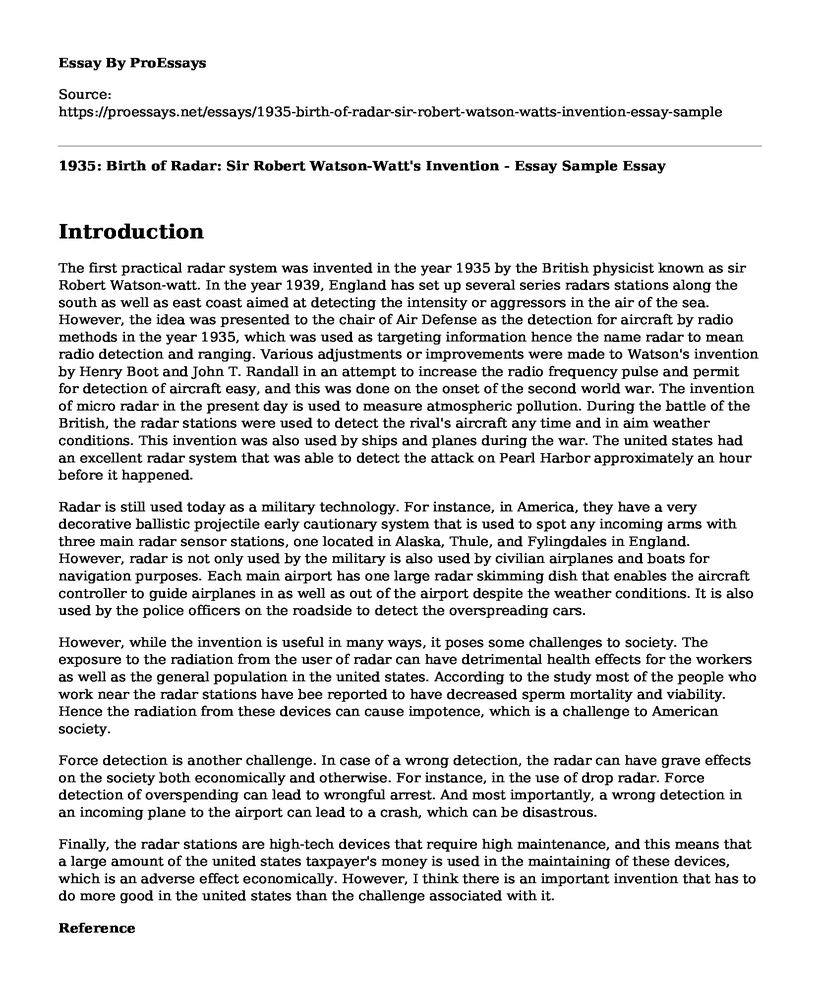Introduction
The first practical radar system was invented in the year 1935 by the British physicist known as sir Robert Watson-watt. In the year 1939, England has set up several series radars stations along the south as well as east coast aimed at detecting the intensity or aggressors in the air of the sea. However, the idea was presented to the chair of Air Defense as the detection for aircraft by radio methods in the year 1935, which was used as targeting information hence the name radar to mean radio detection and ranging. Various adjustments or improvements were made to Watson's invention by Henry Boot and John T. Randall in an attempt to increase the radio frequency pulse and permit for detection of aircraft easy, and this was done on the onset of the second world war. The invention of micro radar in the present day is used to measure atmospheric pollution. During the battle of the British, the radar stations were used to detect the rival's aircraft any time and in aim weather conditions. This invention was also used by ships and planes during the war. The united states had an excellent radar system that was able to detect the attack on Pearl Harbor approximately an hour before it happened.
Radar is still used today as a military technology. For instance, in America, they have a very decorative ballistic projectile early cautionary system that is used to spot any incoming arms with three main radar sensor stations, one located in Alaska, Thule, and Fylingdales in England. However, radar is not only used by the military is also used by civilian airplanes and boats for navigation purposes. Each main airport has one large radar skimming dish that enables the aircraft controller to guide airplanes in as well as out of the airport despite the weather conditions. It is also used by the police officers on the roadside to detect the overspreading cars.
However, while the invention is useful in many ways, it poses some challenges to society. The exposure to the radiation from the user of radar can have detrimental health effects for the workers as well as the general population in the united states. According to the study most of the people who work near the radar stations have bee reported to have decreased sperm mortality and viability. Hence the radiation from these devices can cause impotence, which is a challenge to American society.
Force detection is another challenge. In case of a wrong detection, the radar can have grave effects on the society both economically and otherwise. For instance, in the use of drop radar. Force detection of overspending can lead to wrongful arrest. And most importantly, a wrong detection in an incoming plane to the airport can lead to a crash, which can be disastrous.
Finally, the radar stations are high-tech devices that require high maintenance, and this means that a large amount of the united states taxpayer's money is used in the maintaining of these devices, which is an adverse effect economically. However, I think there is an important invention that has to do more good in the united states than the challenge associated with it.
Reference
Kouemou, G. (Ed.). (2010). Radar technology. BoD-Books on Demand. Retrieved from https://www.nap.edu/read/10394/chapter/5
Cite this page
1935: Birth of Radar: Sir Robert Watson-Watt's Invention - Essay Sample. (2023, Apr 24). Retrieved from https://proessays.net/essays/1935-birth-of-radar-sir-robert-watson-watts-invention-essay-sample
If you are the original author of this essay and no longer wish to have it published on the ProEssays website, please click below to request its removal:
- Introduction to Innovation
- Solar Energy and Wind Energy Discussion Paper Example
- Essay Sample on Innovation: Processes and Procedures to Increase Profitability
- Research Paper on AI: Too Important for Google & Facebook Alone
- Essay Example on Unleashing the Potential of Solar Energy: A History of Innovation
- Maximizing Solar Energy: Exploring Technologies and Resource Availability - Essay Sample
- Essay Example on AI: Transforming Lives with Smart Machines







